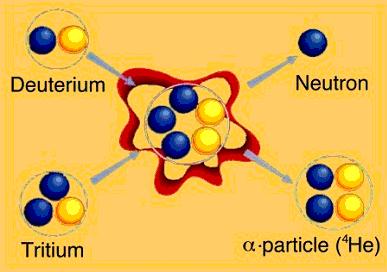Fusion is a reaction whereby two atoms join or fuse together to form one new atom. This reaction can produce a large amount of energy, which incidentally is the energy source of the Sun and the stars. For instance, fusion reactions power the Sun by converting hydrogen into helium. In doing so, fusion converts per second 600 million tons of hydrogen into 596 million tons of helium, producing a total power of 3.6×10 GW. Sun ‘cools’ itself by releasing the energy in all directions via radiation of light and the power flux falling on earth is 1.4 kW/m (above the atmosphere, without absorption). Fusion energy, through solar radiation, has sustained the water cycle, wind and life for billions of years; it is the origin of the key renewable energy on earth.
Fusion reactions involve different nuclei have different reaction rate. Among all reactions the fusion of deuterium (D) and tritium (T), i.e. D-T fusion, converting these two hydrogen isotopes into helium and neutrons, is the easiest to achieve and has been chosen for future fusion power plants.

Source: http://www.iter.org/pics/DTreaction.tiff
The ultimate promise of fusion is a carbon-free, environmentally benign and inexhaustible energy supply for the future of mankind. The key advantages are:
· The basic fuels (isotopes of hydrogen) are abundant and distributed widely around the globe. Deuterium, sufficient for billions of years of power supply, can be extracted easily from sea water. Lithium, from which tritium can be produced, is a readily available light metal in the Earth´s crust sufficient for at least 30,000 years of supply.
· There is no need to process the fuel before hand, the gases are easily separated.
· Fusion produces no greenhouse gases or other gases that have damaging effects on the environment. The fuel and the direct-end products (“ashes”) are neither toxic nor radioactive. Only metal parts close to the fusion plasma will become radioactive. Any radioactive waste generated will be small in volume and the radioactivity will decay over several decades with the possibility of reuse after about 100 years. There is no long-term burden on future generations
· The fusion reaction is inherently safe. The amount of fuel present in the fusion reaction chamber is so small that a large uncontrolled release of energy would be impossible.